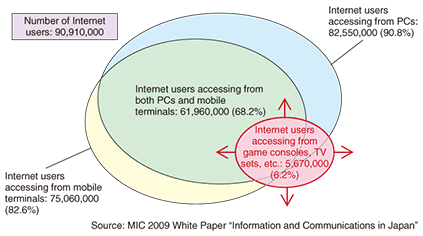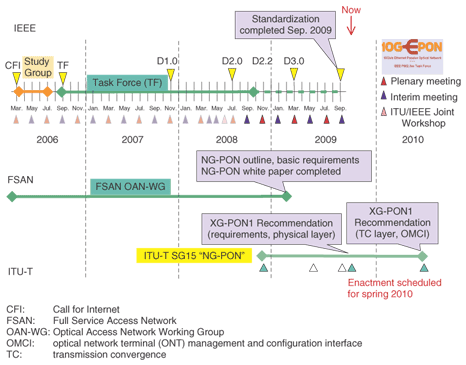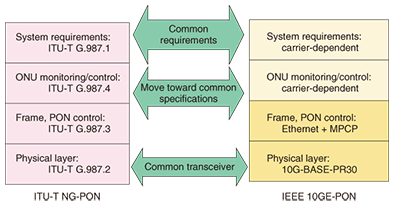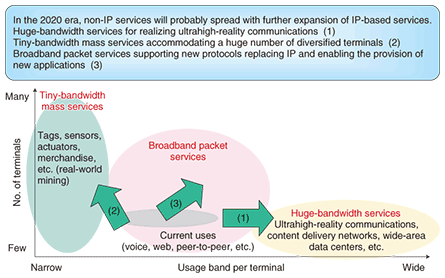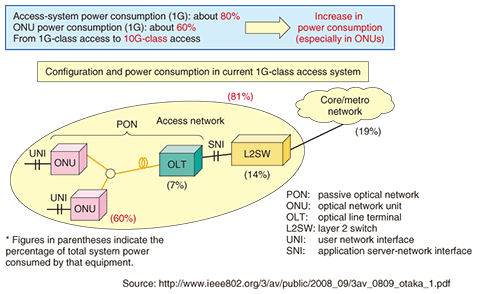 |
|||||
|
|
|||||
|
Special Feature: NTT Tsukuba Forum 2009 Workshop Lectures Vol. 8, No. 5, pp. 24–29, May 2010. https://doi.org/10.53829/ntr201005sf4  Optical Access System Trends toward Further Expansion of Broadband ServicesAbstractThis article introduces trends in the research and development of next-generation passive optical network systems and the current state of technologies supporting the next-generation optical access network.
1. Broadband services today1.1 Dramatic increase in trafficAlthough the number of Internet users in Japan has nearly reached saturation point, Internet traffic continues to increase, with the last two years showing an annual growth rate of about 130%. If this rate continues for the next nine years, traffic will swell to about ten times its present level. This jump in traffic suggests that the way in which people use the Internet is changing rapidly. One factor behind this is the increasing use of social media sites like Facebook and YouTube. The total amount of average traffic per day in Japan at the beginning of 2009 has been calculated to be more than 1 Tbit/s. This figure breaks down to about 10 kbit/s per person, or in other words, to about 100 MB of traffic per user per day. If we convert this quantity to usage time for actual services, we get about 225 minutes of talking time for VoIP (voice over Internet protocol). However, the same amount of data does not amount to much time for video services, as shown below:
The number of users and usage time of such services are certain to grow from here on, doubtlessly resulting in an explosive increase in traffic. The effects of future trends in video services on the access system look to be immense, and they raise the question of how long the existing network architecture will suffice. 1.2 Trends in FTTHThe number of fiber-to-the-home (FTTH) users is steadily increasing as users of DSL (digital subscriber line), which has already entered a period of decline in the net number of users, make the switch to FTTH. In addition to typical Internet access from personal computers (PCs) and mobile phones, recent trends reveal Internet access from non-PC terminals like game consoles and TV sets (Fig. 1).
The growth of video delivery services has certainly been remarkable: IP-based services like HIKARI TV and Gyao NEXT and RF-based services like FLET’S TV are now expanding (RF: radio frequency). The GE-PON (Gigabit Ethernet passive optical network) system based on Ethernet frames is now being used in optical transmission modules. In a PON system, multiple users share one optical fiber, but each optical network unit (ONU) selects the frames destined only for itself on the basis of a logical link identifier, thereby achieving a logical point-to-point transmission scheme. Triple-play services, which can provide voice, data, and video simultaneously, using GE-PON technology are also expanding. From a global perspective, Asia and the Pacific region are leading in terms of FTTH penetration, and video delivery services in North America are becoming a driving force behind the launch of a genuine period of FTTH expansion. Europe, meanwhile, is currently setting up an optical fiber network for general subscribers, indicating that full-scale FTTH penetration is about to take place. The mainstream PON system in Asia and the Pacific region is GE-PON, while that in Europe and North America is G-PON (Gigabit capable passive optical network). Looking forward, we can expect cloud computing and 3D, 4K, and 8K video technologies to expand as part of the broadband-service menu (3D: three-dimensional, 4K: 4096 (4 × 210) pixels, 8K: 9182 (8 × 210) pixels). 2. Next-generation PON systems2.1 Coexistence with existing systemsIt has been five years since the commercial launch of GE-PON, and the timing for commercializing 10G-EPON (10-Gbit/s Ethernet PON) and NG-PON (Next Generation PON)—the next PON-based systems—is now being deliberated. One essential condition in the development of next-generation PON systems is that they must coexist with GE-PON and G-PON, which are widely used at present. Specifically, these new systems must first and foremost be designed to conform to current conditions in the optical wiring network. That is to say, they must deal with limitations like a single-mode fiber having 32 branches from an optical splitter, single-core bidirectional communications, a link budget of 29 dB, and a transmission distance of 20 km. Of utmost importance here is that the introduction of such a new system does not affect users of an existing system; both 1G and 10G users must be accommodated (G denotes approximately 1 Gbit/s). Accommodating both 10G-EPON and GE-PON requires the use of an optical line terminal (OLT) equipped with a dual-rate, burst-mode receiving function that can support either 1G or 10G uplink signals. This will make it possible to provide services suitable for three types of ONUs: 1G uplink and 1G downlink (GE-PON), 1G uplink and 10G downlink (10G-EPON), and 10G uplink and 10G downlink (10G-EPON). 2.2 Standardization schedule and issuesAs in the past, next-generation PON systems are being standardized by different standardization bodies: NG-PON by ITU-T (International Telecommunication Union, Telecommunication Standardization Sector) and 10G-EPON by IEEE [1]. There are consequently slight differences in their standardization schedules. 10G-EPON (IEEE) standardization was completed on September 11, 2009 and the system was ready for commercialization last November. In contrast, NG-PON can be divided into several types depending on requirements such as XG-PON1 (asymmetrical system: 2.5G uplink and 10G downlink; here X stands for the Roman number 10, so XG-PON means 10G-PON) and its standardization (by ITU-T) is moving forward with Recommendations scheduled to be completed in 2010 (Fig. 2).
The scope of standardization differs between IEEE and ITU-T. Comparing existing PON systems, we see that IEEE’s GE-PON (802.3ah) mainly stipulates transmission specifications (physical layer and media access control layer) while ITU-T’s G-PON is also concerned with system specifications such as monitoring and control, reliability, and power-saving characteristics. Other differences include optical interface specifications and transmission frames. Although as much collaboration as possible in standardization would be desirable from the viewpoint of expanding the penetration of next-generation PONs, unification in this regard is difficult. While it is true that common ground has been found in terms of requirements and transceivers and a move toward common specifications for monitoring and control has begun, it appears that the two standardization bodies are irreconcilable when it comes to transmission frames (Fig. 3).
Practical deployment of next-generation PONs is still unclear, but early system development is required to enable quick responses to specific needs that arise. 3. Core technologies for future access networksThe search for network services beyond the Next Generation Network (NGN) has already begun. The launch period for such services is considered to be about 2020, and we can envision service expansion in three directions according to the bit rate and number of terminals (Fig. 4).
In addition to even higher levels of migration, economy, and social-infrastructure reliability, an essential element of constructing an access network beyond the next generation will be research and development toward reduced power consumption and expanded dynamic range. 3.1 Reducing power consumptionIf we break down power consumption in the current (1G) optical access system, we can see that the power used by the core network is less than 20% of the total while the remaining 80% or so is used by the access network (Fig. 5). Of this, ONU power consumption is about 60% of the total. Since the power used by 10G-class services will increase significantly compared with existing usage, the development of power-saving measures, especially for ONUs, is crucial.
We are investigating the introduction of a sleep function as a power-saving measure for ONUs. During times without any traffic, this function would cause the ONU to sleep and awaken intermittently to save energy. For example, an ONU could be made to repeat a cycle consisting of a 20-ms sleep period and 2-ms operation period. Such an approach could decrease power consumption by about 30% for the cost of an additional wakeup delay of less than 100 ms, which seems to be acceptable for most IP-based applications. 3.2 Increasing capacityVarious approaches to increasing capacity are being studied, as discussed below. Several of them utilize multiplexing schemes such as wavelength division multiplexing (WDM), frequency division multiplexing (FDM), and code division multiplexing (CDM). (1) WDM-PON A WDM-PON is an effective technology for providing broadband services by multiplexing users’ signals on the wavelength axis. However, it requires many optical components, which drives up costs. On the other hand, WDM is essential for future 100G-class optical access systems, so finding ways of reducing equipment costs looks like being a major issue. (2) FDM-PON An FDM-PON multiplexes a tightly arranged sequence of many wavelengths by using high-sensitivity receiving technology that makes use of the interference between signal light and locally generated light. This scheme can currently multiplex about 100 wavelengths. It would not be a dream to say that this technology will eventually be able to achieve ultrahigh-capacity communications by multiplexing 1000 wavelengths within a bandwidth of 200 nm. (3) CDM-PON A CDM-PON multiplexes an optical signal by assigning a different code to each user. Since it has the potential to provide efficient spectrum usage with high reliability, we are now working on its practical application for use in future access networks. (4) 10G digital-baseband video delivery system We are also working to construct a large-capacity video delivery system using digital baseband signals. This technology superimposes digital baseband signals on a PON by using WDM to multicast digital video information at 10 Gbit/s. Although it is limited to unidirectional communications, it is capable of ultrahigh-capacity transmission. This technology should reach a practical stage in the near future. 4. ConclusionThe way that people enjoy and use the Internet is changing, and the key to understanding this change is video service trends. Commercialization of next-generation PONs, whose basic premise is coexistence with existing systems, is about to commence. Core technologies for the access network must be further enhanced with an eye to expanding future network services. Reference
ProfileCareer highlightsSenior Research Engineer, Executive Manager of the Optical Access Systems Project, NTT Access Network Service Systems Laboratories. Hisaya Hadama received the B.S. and M.S. degrees from Kyushu University and the D.Eng. degree from Osaka University in 1985, 1987, and 1997, respectively. After joining NTT in 1987, he engaged in research on ATM virtual path transport networks and multimedia services over broadband networks. From 1994 to 1995, he researched multimedia network control techniques as a visiting researcher at CTR, Columbia University, USA. After returning to Japan, he worked to develop NTT’s R&D strategy for the Global Megamedia Network, which aimed to provide affordable broadband network services. From 2003 to 2005, he was engaged in research on ubiquitous network service systems, including RFID tag-based healthcare systems and the Wide Area Ubiquitous Network. From 2007 to 2009, he worked on the architectural design of future carrier networks in NTT Network Innovation Laboratories. His research activities are currently focused on developing next-generation FTTH systems. He is a member of the Institute of Electronics, Information and Communication Engineers of Japan, the Information Processing Society of Japan, and IEEE. |
|||||








